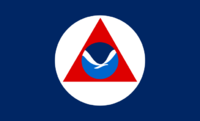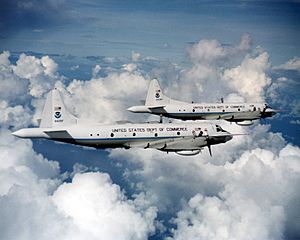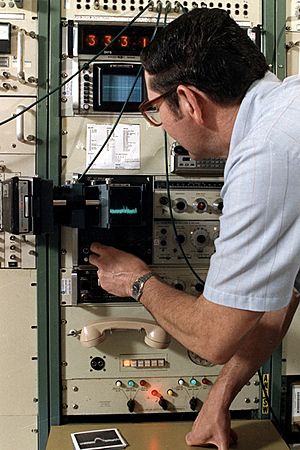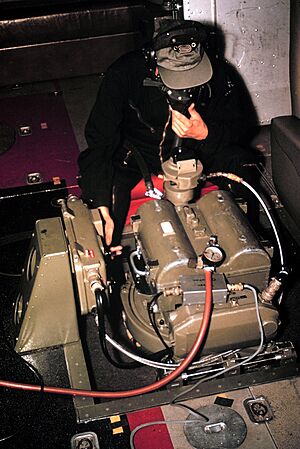National Oceanic and Atmospheric Administration facts for kids

Logo and wordmark of the National Oceanic and Atmospheric Administration
|
|

Flag of NOAA
|
|
 Two NOAA WP-3D hurricane hunter aircraft |
|
| Agency overview | |
|---|---|
| Formed | October 3, 1970 |
| Preceding agencies |
|
| Jurisdiction | Federal government of the United States |
| Headquarters | Silver Spring, Maryland 38°59′32″N 77°01′50″W / 38.99222°N 77.03056°W |
| Employees |
|
| Annual budget | $6.9 billion (est. 2022) |
| Agency executive |
|
| Parent agency | US Department of Commerce |
| Child agencies |
|
The National Oceanic and Atmospheric Administration (NOAA) is a science agency in the United States. It helps us understand our planet's oceans and atmosphere. NOAA's main jobs include predicting the weather, exploring the deep sea, and protecting marine animals. It also manages fishing and helps keep our coasts safe. NOAA is part of the United States Department of Commerce and has its main office in Silver Spring, Maryland.
Contents
- History of NOAA
- How NOAA is Organized
- NOAA Headquarters
- NOAA Leadership
- Why NOAA is Important
- What NOAA Does
- National Weather Service (NWS)
- National Ocean Service (NOS)
- National Environmental Satellite, Data, and Information Service (NESDIS)
- National Marine Fisheries Service (NMFS)
- Office of Oceanic and Atmospheric Research (OAR)
- Office of Marine and Aviation Operations (OMAO)
- NOAA Commissioned Officer Corps
- NOAA Flag
- Images for kids
- See also
History of NOAA
NOAA's story goes back a long way, even before it was officially created. It grew from several older government groups.
- The United States Coast and Geodetic Survey started in 1807. This group mapped the coasts and waters.
- The Weather Bureau began in 1870. It was in charge of weather forecasts.
- The Bureau of Commercial Fisheries started in 1871. It focused on fish research.
In 1965, many of these science groups joined together to form the Environmental Science Services Administration (ESSA). This was a big step towards creating NOAA.
NOAA was officially formed on October 3, 1970. President Richard Nixon wanted a new agency to better protect people and property from natural dangers. He also wanted to help us understand our environment and use ocean resources wisely.
NOAA became part of the Department of Commerce. This happened partly because of a disagreement between President Nixon and his interior secretary, Wally Hickel.
In 2007, NOAA celebrated 200 years of service. This marked its long history of mapping and surveying the U.S. coast.
As of 2021, NOAA had about 11,833 civilian employees. It also has 321 uniformed service members in the NOAA Commissioned Corps. These members help with research and operations.
In early 2025, NOAA experienced some big changes. Several hundred staff members were laid off. By March 2025, about 1,300 NOAA staff members were laid off. Also, the Department of Defense announced it would no longer share important weather data with NOAA.
How NOAA is Organized
NOAA Headquarters
Since 1993, NOAA's main office has been in Silver Spring, Maryland. This large campus has four buildings and is home to over 40 NOAA offices. This includes the National Weather Service.

NOAA Leadership
Laura Grimm is currently the Acting Administrator for NOAA. She also serves as the Acting Under Secretary of Commerce for Oceans and Atmosphere. She took on this role on March 31, 2025.
Why NOAA is Important
NOAA was created by a special order in 1970. Even though it's very important, it has never been officially set up by a law. In January 2023, a plan was discussed to make NOAA an independent agency. This would mean it wouldn't be part of the Commerce Department anymore. The goal was to make sure NOAA continues to receive the funding it needs.
What NOAA Does
NOAA carries out its mission through six main offices. These offices work together to protect our planet and help people.
- National Environmental Satellite, Data, and Information Service (NESDIS)
- National Marine Fisheries Service (NMFS)
- National Ocean Service (NOS)
- National Weather Service (NWS)
- Office of Oceanic and Atmospheric Research (OAR)
- Office of Marine and Aviation Operations (OMAO)
NOAA also has many other offices, like the NOAA Central Library.
National Weather Service (NWS)
The National Weather Service (NWS) gives us weather, water, and climate forecasts. It also issues warnings for the United States. This helps protect lives and property. The NWS does this through many local weather offices and special centers.
They issue hundreds of thousands of forecasts and warnings every year. NOAA's data is also important for understanding climate change.
The NWS uses a network of Doppler weather radars called NEXRAD. These radars can detect rain and snow, and how fast they are moving. Many of their forecasts are broadcast on NOAA Weather Radio. This radio network shares weather updates 24 hours a day.
National Ocean Service (NOS)
The National Ocean Service (NOS) works to keep our oceans and coastal areas safe and healthy. NOS scientists and experts help with safe shipping. They also find new ways to protect coastal communities. And they work to save important marine and coastal places.
The NOS has several program offices. These include the Office of Coast Survey and the Office of National Marine Sanctuaries.
National Environmental Satellite, Data, and Information Service (NESDIS)
The National Environmental Satellite, Data, and Information Service (NESDIS) manages U.S. environmental satellites. It also handles weather data from NOAA and other government groups. NESDIS's National Centers for Environmental Information (NCEI) stores this data. This includes information from the U.S. Navy, Air Force, and other weather services.
NESDIS has managed satellites since the 1960s. These satellites help us see weather patterns and changes on Earth. They include polar-orbiting satellites and geosynchronous satellites.
National Marine Fisheries Service (NMFS)
The National Marine Fisheries Service (NMFS), also known as NOAA Fisheries, started in 1871. Its main goal is to research, protect, and manage fishing. It also works to restore fish habitats and protect endangered species.
NMFS has offices and laboratories across the U.S. and its territories. These places are where they research and manage marine resources. The National Oceanic and Atmospheric Administration Fisheries Office of Law Enforcement helps enforce laws about marine resources.
Office of Oceanic and Atmospheric Research (OAR)
NOAA's research arm is the Office of Oceanic and Atmospheric Research (OAR). This research helps NOAA create products and services that protect people and support the economy. OAR studies things like tornadoes, hurricanes, and climate changes. They also look at ocean currents and the health of coastal ecosystems.
OAR has seven research laboratories. It also works with many universities and research programs. Thousands of scientists and students help learn more about natural events that affect us all.
One of OAR's labs is the Atlantic Oceanographic and Meteorological Laboratory (AOML) in Miami, Florida. AOML studies hurricanes, coastal ecosystems, and oceans.
Office of Marine and Aviation Operations (OMAO)
The Office of Marine and Aviation Operations (OMAO) is in charge of NOAA's ships, aircraft, and diving operations. It has the largest research fleet in the U.S. government. Its staff includes federal employees and members of the NOAA Commissioned Corps.
NOAA Commissioned Officer Corps
The NOAA Commissioned Officer Corps is a uniformed service. Its members operate NOAA ships and aircraft. They also work in science and administrative jobs.
NOAA Flag
NOAA's flag is based on the flag of an older group, the United States Coast and Geodetic Survey. That flag, used since 1899, was blue with a white circle and a red triangle inside. This design showed how they used triangles to map areas.
When NOAA was created in 1970, it used a similar flag. The NOAA flag has the NOAA logo inside the red triangle. NOAA ships fly this flag to show they belong to NOAA. They also fly the same ensign (a type of flag) as U.S. Navy ships.
Images for kids
See also
 In Spanish: Oficina Nacional de Administración Oceánica y Atmosférica para niños
In Spanish: Oficina Nacional de Administración Oceánica y Atmosférica para niños





